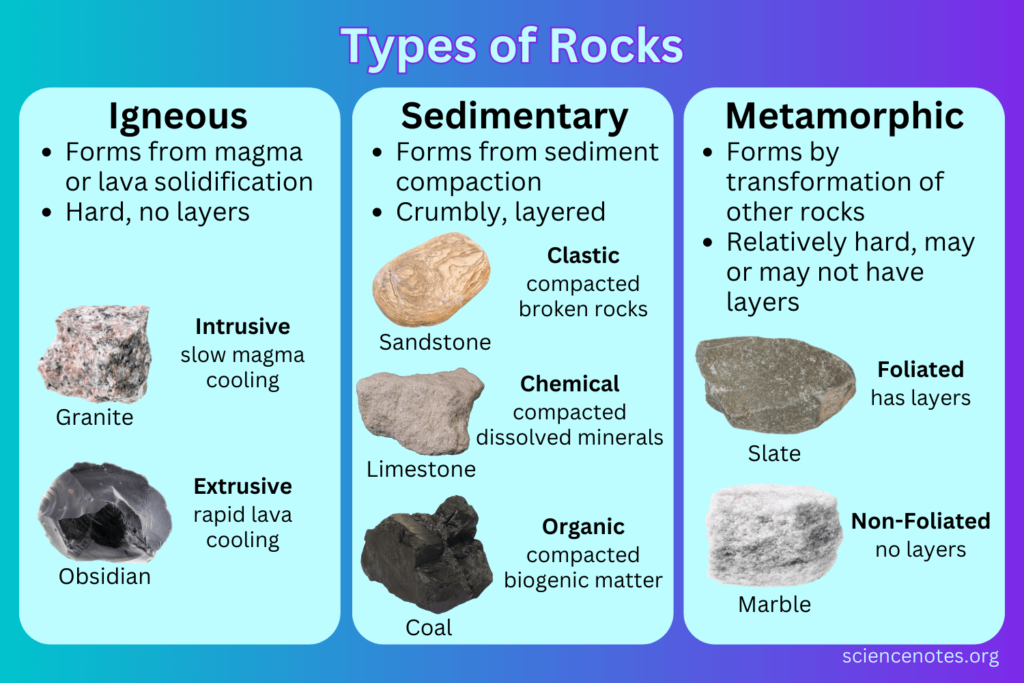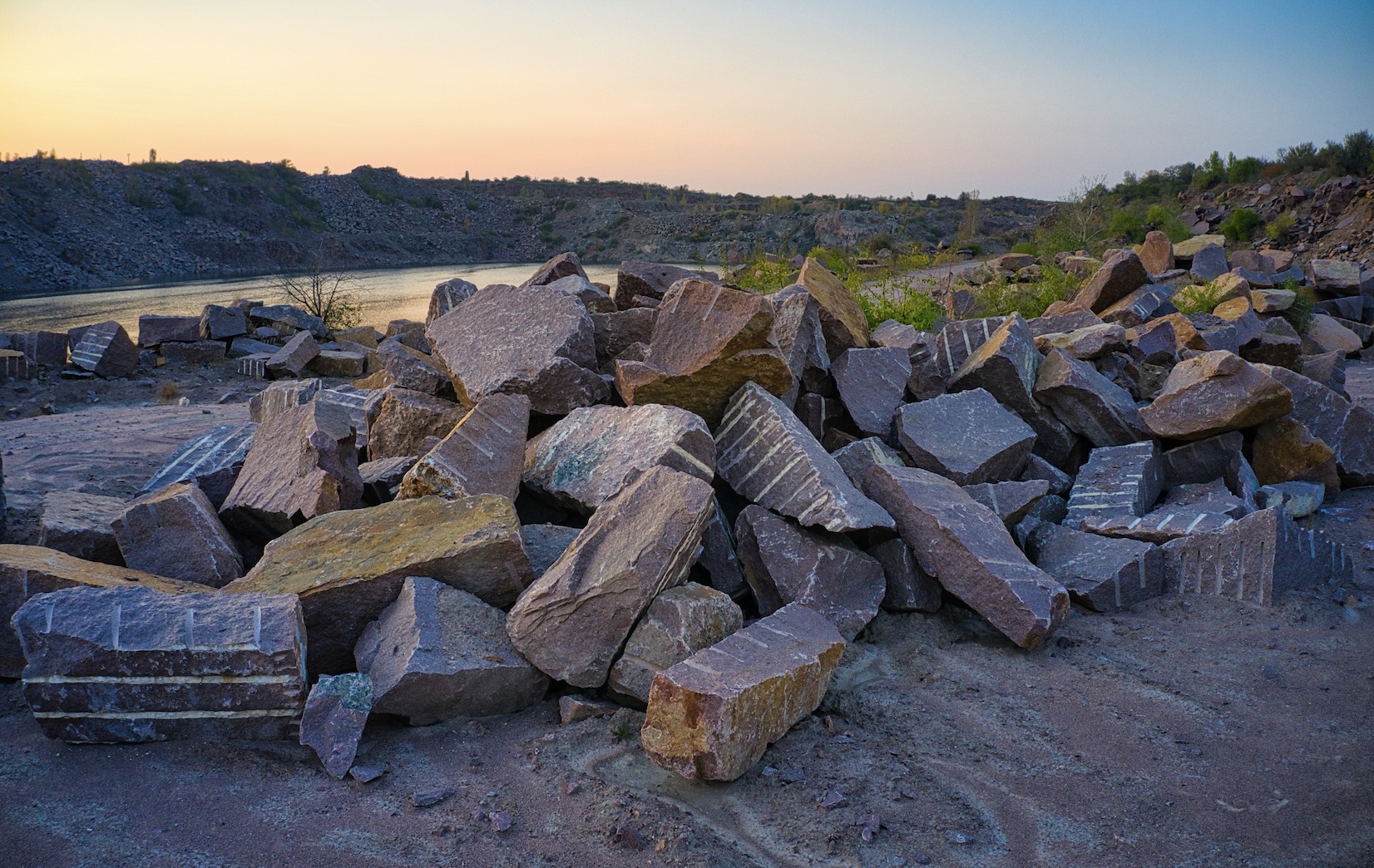This comprehensive guide, titled “Geography Grade 10 Questions and Answers PDF Term 3,” aims to address the critical environmental and societal issues covered in...
Welcome to your Grade 10 Geography notes on Types of Rocks! This guide will help you understand the different types of rocks, their formation processes, and their significance in the study of geomorphology. By the end of this section, you will have a solid understanding of the rock cycle and the characteristics of various rock types.
Types of Rocks

- Igneous Rocks
- Formation: Formed from the cooling and solidification of magma or lava.
- Types:
- Intrusive Igneous Rocks: Formed from magma that cools slowly beneath the Earth’s surface (e.g., granite).
- Extrusive Igneous Rocks: Formed from lava that cools quickly on the Earth’s surface (e.g., basalt).
- Characteristics: Generally hard and durable, often containing crystals.
- Sedimentary Rocks
- Formation: Formed from the accumulation and compaction of sediment, often in water bodies.
- Types:
- Clastic Sedimentary Rocks: Made from fragments of other rocks (e.g., sandstone).
- Chemical Sedimentary Rocks: Formed from the precipitation of minerals from water (e.g., limestone).
- Organic Sedimentary Rocks: Made from the remains of living organisms (e.g., coal).
- Characteristics: Often layered, may contain fossils, and are generally softer than igneous rocks.
- Metamorphic Rocks
- Formation: Formed from the alteration of existing rock types (igneous, sedimentary, or other metamorphic rocks) due to heat, pressure, and chemical processes.
- Types:
- Foliated Metamorphic Rocks: Have a layered or banded appearance (e.g., schist).
- Non-Foliated Metamorphic Rocks: Do not have a layered appearance (e.g., marble).
- Characteristics: Often have a crystalline texture and are harder than their original rock types.
The Rock Cycle
- Introduction to the Rock Cycle
- Definition: The rock cycle is a continuous process by which rocks are formed, broken down, and reformed over geological time.
- Processes:
- Weathering and Erosion: Breakdown of rocks into smaller particles.
- Sedimentation: Deposition and compaction of sediment to form sedimentary rocks.
- Metamorphism: Transformation of rocks under heat and pressure to form metamorphic rocks.
- Melting and Solidification: Melting of rocks to form magma, which then cools to form igneous rocks.
Importance of Understanding Rock Types
Understanding the different types of rocks and the rock cycle is essential for studying the Earth’s crust and its dynamic processes. This knowledge helps in exploring natural resources, understanding soil formation, and studying geological history.
Downloadable Notes
- Geography-Grades10-to-12-GIS-concepts-simplified-PPTs (Download)
- Geography-Grade-10-Geomorphology-Types-of-rocks-PPTs (Download)
These resources will provide further insights and help reinforce your understanding of the types of rocks and their significance. Make sure to review the presentations to get a comprehensive understanding of the topic.
Questions and Answers Activities
True or False: Igneous rocks are formed from the cooling and solidification of magma or lava.
Answer: True
Explanation: Igneous rocks form when magma (beneath the Earth’s surface) or lava (on the Earth’s surface) cools and solidifies. The cooling process determines the type of igneous rock formed.
Multiple Choice: Which type of igneous rock is formed from magma that cools slowly beneath the Earth’s surface?
A. Basalt
B. Granite
C. Limestone
D. Coal
Answer: B. Granite
Explanation: Granite is an intrusive igneous rock that forms from magma cooling slowly beneath the Earth’s surface, allowing large crystals to develop.
Fill in the Blank: Sedimentary rocks that are made from fragments of other rocks are called _______ sedimentary rocks.
Answer: Clastic
Explanation: Clastic sedimentary rocks are formed from the accumulation and compaction of fragments of other rocks. Example: Sandstone.
Short Answer: Describe the formation process of organic sedimentary rocks and give an example.
Answer: Organic sedimentary rocks form from the remains of living organisms, such as plants and animals. An example is coal, which forms from compacted plant material over millions of years.
Explanation: Organic sedimentary rocks originate from the accumulation and compaction of organic material. For instance, coal is created from ancient plant remains that have been subjected to pressure over long periods.
Matching: Match the type of rock with its characteristic.
A. Igneous Rocks
B. Sedimentary Rocks
C. Metamorphic Rocks
- Often layered and may contain fossils.
- Generally hard and durable, often containing crystals.
- Often have a crystalline texture and are harder than their original rock types.
Answers:
A – 2
B – 1
C – 3
Explanation:
- Igneous Rocks are hard and durable, often containing crystals.
- Sedimentary Rocks are often layered and may contain fossils.
- Metamorphic Rocks have a crystalline texture and are harder than their original rock types.
True or False: Metamorphic rocks are formed from the accumulation and compaction of sediment.
Answer: False
Explanation: Metamorphic rocks form from the alteration of existing rock types (igneous, sedimentary, or other metamorphic rocks) due to heat, pressure, and chemical processes, not from sediment accumulation.
Multiple Choice: Which type of sedimentary rock is formed from the precipitation of minerals from water?
A. Clastic
B. Chemical
C. Organic
D. Intrusive
Answer: B. Chemical
Explanation: Chemical sedimentary rocks form from the precipitation of minerals from water. Limestone is a common example, formed from dissolved calcium carbonate.
Fill in the Blank: Metamorphic rocks that have a layered or banded appearance are called _______ metamorphic rocks.
Answer: Foliated
Explanation: Foliated metamorphic rocks have a distinct layered or banded appearance due to the alignment of mineral grains under directional pressure. Example: Schist.
Short Answer: Explain the difference between intrusive and extrusive igneous rocks with examples.
Answer: Intrusive igneous rocks form from magma that cools slowly beneath the Earth’s surface, resulting in large crystals. Example: Granite. Extrusive igneous rocks form from lava that cools quickly on the Earth’s surface, resulting in small crystals. Example: Basalt.
Explanation: Intrusive igneous rocks (like granite) cool slowly beneath the Earth’s surface, allowing crystals to grow larger. Extrusive igneous rocks (like basalt) cool quickly on the Earth’s surface, leading to smaller crystals.
Matching: Match the type of metamorphic rock with its description.
A. Foliated Metamorphic Rocks
B. Non-Foliated Metamorphic Rocks
- Have a layered or banded appearance.
- Do not have a layered appearance.
Answers:
A – 1
B – 2
Explanation:
- Foliated Metamorphic Rocks have a layered or banded appearance due to pressure. Example: Schist.
- Non-Foliated Metamorphic Rocks do not have a layered appearance and often have a uniform texture. Example: Marble.
True or False: Basalt is an example of an intrusive igneous rock.
Answer: False
Explanation: Basalt is an extrusive igneous rock, formed from lava that cools quickly on the Earth’s surface, resulting in fine-grained texture.
True or False: Granite is an example of an extrusive igneous rock.
Answer: False
Explanation: Granite is an intrusive igneous rock, formed from magma that cools slowly beneath the Earth’s surface, resulting in large crystals.
Multiple Choice: Which type of metamorphic rock is characterized by a non-layered appearance?
A. Schist
B. Slate
C. Marble
D. Gneiss
Answer: C. Marble
Explanation: Marble is a non-foliated metamorphic rock that does not have a layered appearance, unlike foliated metamorphic rocks such as schist, slate, and gneiss.
Fill in the Blank: Rocks that form from the cooling and solidification of lava are called _______ igneous rocks.
Answer: Extrusive
Explanation: Extrusive igneous rocks form from the cooling and solidification of lava on the Earth’s surface. An example is basalt.
Short Answer: What are clastic sedimentary rocks and how do they form? Provide an example.
Answer: Clastic sedimentary rocks are formed from fragments of other rocks that are compacted and cemented together. An example is sandstone, which is made from compacted sand particles.
Explanation: Clastic sedimentary rocks form from the mechanical weathering of other rocks, where the fragments are transported, deposited, and then compacted and cemented over time. Sandstone is a common example, consisting of sand-sized particles.
Matching: Match the type of rock with its formation process.
A. Igneous Rocks
B. Sedimentary Rocks
C. Metamorphic Rocks
- Formed from the cooling and solidification of magma or lava.
- Formed from the accumulation and compaction of sediment.
- Formed from the alteration of existing rocks due to heat, pressure, and chemical processes.
Answers:
A – 1
B – 2
C – 3
Explanation:
- Igneous Rocks: Formed from the cooling and solidification of magma or lava.
- Sedimentary Rocks: Formed from the accumulation and compaction of sediment.
- Metamorphic Rocks: Formed from the alteration of existing rocks due to heat, pressure, and chemical processes.
True or False: Schist is an example of a foliated metamorphic rock.
Answer: True
Explanation: Schist is a foliated metamorphic rock that has a layered or banded appearance due to the alignment of mineral grains under directional pressure.
Multiple Choice: Which of the following is an example of a chemical sedimentary rock?
A. Sandstone
B. Basalt
C. Limestone
D. Granite
Answer: C. Limestone
Explanation: Limestone is a chemical sedimentary rock formed from the precipitation of minerals, primarily calcium carbonate, from water.
Fill in the Blank: _______ rocks often contain fossils and are generally softer than igneous rocks.
Answer: Sedimentary
Explanation: Sedimentary rocks often contain fossils and are generally softer than igneous rocks because they form from the accumulation and compaction of sediment, which can include organic material and minerals precipitated from water.
Short Answer: Explain how foliated metamorphic rocks differ from non-foliated metamorphic rocks. Give an example of each.
Answer: Foliated metamorphic rocks have a layered or banded appearance due to the alignment of minerals under pressure. An example is schist. Non-foliated metamorphic rocks do not have a layered appearance and have a more uniform texture. An example is marble.
Explanation: Foliated metamorphic rocks like schist exhibit layers or bands resulting from pressure that causes mineral grains to align. Non-foliated metamorphic rocks like marble lack this banding and have a uniform texture, typically formed under conditions where pressure is more uniform.
Matching: Match the type of sedimentary rock with its formation process.
A. Clastic Sedimentary Rocks
B. Chemical Sedimentary Rocks
C. Organic Sedimentary Rocks
- Made from fragments of other rocks compacted and cemented together.
- Formed from the precipitation of minerals from water.
- Made from the remains of living organisms.
Answers:
A – 1
B – 2
C – 3
Explanation:
- Clastic Sedimentary Rocks: Made from fragments of other rocks compacted and cemented together. Example: Sandstone.
- Chemical Sedimentary Rocks: Formed from the precipitation of minerals from water. Example: Limestone.
- Organic Sedimentary Rocks: Made from the remains of living organisms. Example: Coal.
True or False: Marble is an example of a foliated metamorphic rock.
Answer: False
Explanation: Marble is a non-foliated metamorphic rock, characterized by a uniform texture and lack of a layered or banded appearance.






